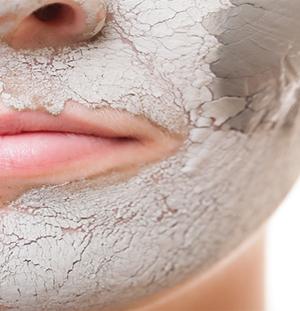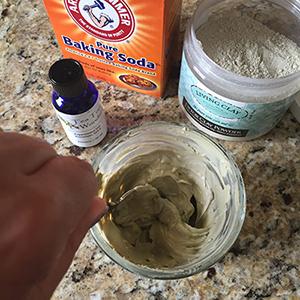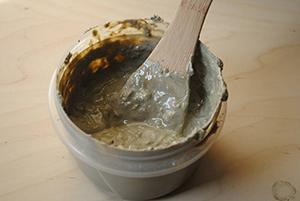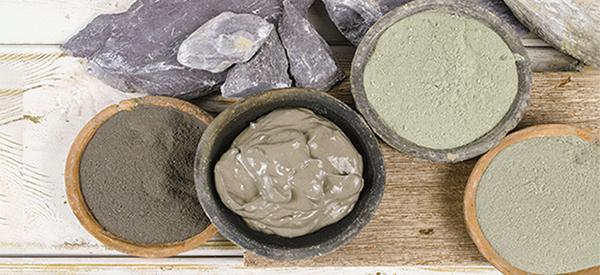Are you familiar with the many uses of Bentonite clay? This natural mineral clay has the ability to clean out toxins, bacteria, viruses, and heavy metals from water, soil, and our bodies. In a disaster situation, its use can protect your health, or even save your life.
How Bentonite Clay Works
Bentonite clay works in a variety of ways to provide beneficial health benefits to the body. Its main benefits stem from three of its properties: it is absorbent, it has a negative charge when wet, and it contains nutrients and passes through the body without any harm. We will discuss each of these properties in a little more detail within this article, but it is important to know that these properties give bentonite clay its healthful properties.
Bentonite clay ionizes when wet to form a negatively charged ion. Since most heavy metal toxins and many other poisonous substances are positively charged, it attracts the toxin and binds to it. As the Bentonite clay passes through the body, it binds up toxins and flushes them out of the body.
Bentonite Clay for Health Benefits
#1.Bentonite Clay Helps Detox the Body
We are exposed to a wide variety of toxins on a daily basis, no matter how clean we eat. Common household products like cleaning supplies, markers, pesticides, gas fumes, and even the materials used to build our homes, give off toxins such as mercury, cadmium, lead, benzene, petroleum-based products, and other harmful substances. Exposure to these substances will likely be even more pronounced during a disaster situation, as we have seen in recent hurricane and flooding events.
Harmful toxins get into the water supply, into our foods, into the air we breathe and become concentrated in our bodies. However, Bentonite clay, taken internally, binds to the toxins in our digestive system and removes them from the body.
To take Bentonite clay by mouth, take 1/2 to 1 teaspoon of clay dry with food, or mix it into a few ounces of water, shake it well, and drink it quickly. The clay won’t dissolve, so you may need to shake again as you drink. Do this once a day.
Taking Bentonite clay is a good detox practice now to get your body healthy, but will be even more useful in a disaster situation where toxins may be released into the environment through neglect.
#2. Take Bentonite Clay as a Supplement
In addition to its benefit for detoxing, Bentonite also contains nutrients that your body needs including, calcium, magnesium, copper, iron, potassium, silica, and sulfur. When you eat or drink the clay, your body absorbs these valuable minerals and many other trace minerals and uses them to build and repair body tissue.
 #3. Use Bentonite Clay in Your Bath to Remove Toxins from the Skin
#3. Use Bentonite Clay in Your Bath to Remove Toxins from the Skin
Add a half cup or more of Bentonite clay to your bath water and soak in it. The clay quickly binds up with toxins released through the skin and prevents them from being reabsorbed. Your skin will feel soft and smooth. As a bonus it helps reduce inflammation in skin irritations.
This tip will become very important if you are bathing in a questionable water source. Add the clay to your sponge bath water, even if you don’t have the opportunity to soak. It will bind up toxins in the water and from your skin.
#4. Use as a Mask or Poultice to Reduce Skin Irritations and Speed Healing
Combine the clay with enough water to make a thick paste and spread it onto areas of skin irritations such as poison ivy, allergic reactions, and red or inflamed skin. The clay binds to bacteria, viruses, and toxin in the skin pores and draws them from the pore. It acts as a mild antibiotic and helps reduce infections and speed up healing of wounds or irritations.
#5. Take Bentonite as a Treatment for Digestive Problems
Studies show that bentonite clay is good at absorbing and neutralizing the bacteria, viruses, and toxins that cause many of our digestive problems. These problems are likely to become more pronounced during a survival situation, so having a stockpile on hand could prove life-saving. Use it for any digestive issue including constipation, nausea, IBS, morning sickness, and food poisoning. Mix ¼ cup or less into your water and drink. You should begin to feel better quickly.
 #6. Use as a Toothpaste or Mouthwash to Protect Teeth and Gums
#6. Use as a Toothpaste or Mouthwash to Protect Teeth and Gums
When you use the last of that tube of toothpaste, remember the Bentonite clay you have stockpiles and break it out. Bentonite clay binds to bacteria, toxins, and other unhealthy substances on the teeth and gums and removes them from the mouth. Use the clay on your toothbrush or mix it in water as a mouth rinse.
#7. Use Bentonite Clay to Purify Water
Since bentonite removes toxins from the water and neutralizes bacteria and viruses, it makes an excellent ingredient in your water purification kit. Use it to remove toxins and heavy metals before the final trip through your survival filter or before boiling.
Related: Disinfect Huge Amounts Of Water With This Common Household Item
#8. Use Bentonite Clay to Prevent Chaffing
In the heat of summer, with no air conditioning, prickly heat and chaffing quickly become a big problem for some people. Bentonite clay, applied in the folds of the skin, absorbs the moisture and reduces inflammation. Apply a fine dusting to the skin and wipe or rinse it away when it becomes damp.
#9.Use Bentonite Clay to Treat Bug Bites, Bee Stings, and Small Wounds
Make a paste by adding a little water to the clay and apply it directly to bug bites, scratches, and other small wounds. The clay will draw out the sting and calm the inflammation. Leave it on the wound or bite for a few hours, then wash away. You can reapply if needed.
Household Uses of Bentonite Clay
#10.Use as an Absorbent
Bentonite’s absorbent properties make it an excellent choice to absorb liquids and odors. It is currently used in kitty litter, and can perform the same benefits for humans in an emergency situation. It is also useful for absorbing oil and grease.
Use Bentonite in your emergency toilet kit as an absorbent and odor reducer. Add a layer of clay after each use.
#11. Clean Contaminated Soils
Bentonite binds organic chemical compounds, heavy metals, pesticides, and other toxins found in contaminated soils. By mixing Bentonite into contaminated soil, it may be helpful to bind up soil contaminates. Keep in mind, however, that in a survival situation, there is no way to know what contaminates exist in the soil. Plant your garden on soil that is believed to be uncontaminated and mix Bentonite into the soil as a precaution.
Related: How to Adjust the pH in Soil and Water for Abundant Harvests
#12. Use as a Desiccant
Because Bentonite absorbs water well, it acts as a desiccant to draw moisture out of humid air or even to keep your stored food dry. Make a packet of dry Bentonite clay with a coffee filter, much like a tea bag, and place it into your dry food stores. The clay is food safe and absorbs moisture well. In humid areas, bake the clay packs in a low oven or place them in a dehydrator for a few hours to draw out all moisture and refresh them for future use.
#13. Use Bentonite Clay as an Emergency Dry Hair Cleanser
During survival situations, a hot shower or even a quick shampoo may be impossible. Use the clay to absorb oils from the hair and give you a little more time before your next shampoo. Rub it into dry hair, allow it to sit for a few minutes, then comb brush it thoroughly to remove the clay and oil.
 #14.Use Bentonite Clay as a Deodorant
#14.Use Bentonite Clay as a Deodorant
Mix Bentonite clay with coconut oil to make a thick paste. Add a few drops of your favorite essential oil if you like, but it is not necessary. Apply the paste with your fingertips and store the remainder in a small jar for future use. The clay will absorb moisture and odor.
#15.Use Bentonite Clay to Clean Your Fruits and Veggies
In a disaster situation, you may not be able to trust the cleanliness of your food supply. Adding a little Bentonite clay to the wash water for your fruits and vegetables will help neutralize viruses and bacteria and bind up potential toxins on the surface of the skin to be washed away.
Stockpiling Bentonite Clay
Bentonite clay stores easily, without the need for any treatment. Simply place it in a food safe bucket and it will keep indefinitely. One caution, however, is to take care to select a high-quality Bentonite clay that is safe for consumption. Do your research and make sure the brand you choose is safe.
Now that you see how useful the stuff is, you’ll want to stock up for a potential survival situation. The amounts you need will depend on how you intend to use it. But it is impossible to predict how useful this clay might be in a toxic environment in the future.
Do You know other uses for Bentonite Clay? If so, please let us know in the comments. I’ve tried to be complete, but I’m sure some of you probably know a few that I’ve missed.
You may also like:
18 Reasons to Stock Diatomaceous Earth for Survival
Discover The Lost Ways 2 By Claude Davis (Video)
23 Medicinal Plants the Native Americans Used on a Daily Basis
















Bentonite clay will set up like concrete to become a waterproof seal when it dries/cures. A common use for this feature is to grout around steel well casing for a suitable distance from ground level down in order to prevent surface contaminants from seeping down into the water table being accessed. I’ve also used it for similar low pressure sealing jobs, such as around waste pipes where they go through the wall of a container from a buried line…simply pack a wet mixture all around where the materials join.
Ŧhat does not sound good for the digestive tract… it may set up as concrete.
Which is why you put some (1 tsp or so) in a glass, and add water to fill at least an 8 oz glass, and stir, and let it sit overnight and then just drink the cloudy water and not the clay itself. Or continuously stir it and drink it .
Don’t try eating it dry!!!
Bentonite clay can also be use to seal the bottom of a small pond if your soil is porous and you want the pond to hold water
Bentonite improves receiving and transmitting radio grounds . Pour a slurry of bentonite into the hole the ground rod is in.
Hey Bob, as soil and rock conduct Earth energy, would there be any transmission improvement by putting the Clay specifically into soil under and around your living spaces, like patios, jacuzzis, gardens, porches? Or do you have to have the metal rod to achieve energetic transmission?
wher do you buy it?
Put _bulk bentonite clay suppliers_ in the web browser. You might add your county, as well.
Minerals technologies inc.
It can be purchased from a farm and garden store. You can get it in large bags, 30-50 lbs.
Make sure to get food grade if you are going to consume it. Lots of places sell it, Amazon, MRH, etc. But again, make sure to get the food grade
1. Search (DuckDuckG or Google) for Bentonite and your zip code.
2. Check pet and grocery stores fo kitty litter that has bentonite as an ingredient. Works well for most grounds.
I use Bentonite in my red and white wines. Bentonite acts as a clearing agent and purifier
While this may seem to be a risky application, but the coffee filter adaptation seems reasonable. I live in a Motorhome in the Willamette valley in Oregon. A climate known for moderate temperatures and high humidity. I lost a computer motherboard because I brought a warm computer into an unheated Motorhome where the computer was allowed to cool. The humidity was high enough tor condensation to form on the motherboard when it cooled. Upon turning it back on hours later, it shorted out the motherboard. At least that was the only explanation I could deduce as to the cause. The computer was in my backpack most of the time. I had 6 Calcium chloride collectors, but none inside the backpack because I don’t like dealing with aqueous CaCl solution everywhere. Bentonite coffee filter packets with outside edges hot-melt glued together enclosing the Bentonite, could safely be placed in close proximity to the laptop placed in the Backpack to absorb the moisture. Technique refinement might need some T&E adjustments , but success is suspected to be in close proximigy.
its also used for water proofing the out side of under ground walls before they back fill , as a water stop
Very much enjoying Lost Ways, and the additional E-Books. Thanks
We have used it years ago to seal a leaky irritation ditch when craw dad’s ca u sedona leaks.
Last year I was bitten on the hip by a brown recluse, by the time I figured that out several days later I had a nickel-sized circle of black dead flesh inside a swollen baseball-sized ring. Knowing that any doctor would have tried cutting it out, I chose to treat it myself with a mixture of bentonite clay, activated charcoal, and psyllium husk powder.
All I did was mix equal parts of each with a little water and stir-stir-stir, adding drips of water until I got a blob the consistency of silly-putty. I pinched off enough to cover the wound and covered it all up with a bandage, wrapping the remaining blob tightly in plastic for later. May goal was to keep the clay-based poultice moist (the psyllium powder helps to keep it hydrated) so it could draw the poisons out for hours at a time. The activated charcoal was essential for detoxifying the wound while the poisons are being drawn out at the same time. I changed the poultice three times a day (throwing the used ones out of course!) until my brown recluse bite completely healed. It took about three weeks for the swelling and dead flesh to disappear entirely, leaving only new healthy pink skin.
Now a year later I have a very faint smudge of a scar, barely visible. Many of my neighbors have huge scars and horror stories about their doctors cut the dead flesh out, usually resulting in very serious infections that went on for months before their wounds finally healed.
IMPORTANT: this comment is entirely about what I chose to do, my personal experience, and why I absolutely didn’t want to go to a doctor if I didn’t have to — but that said, anyone reading this message should do their own research and make their own decisions regarding treatment by medical professionals.
Great info. Thanks!
In regards to treating a Brown Recluse bite: I like the details of the above treatment and the reported results. I had similar results by using liquid goldenseal root and a large band aid as a poultice on a Brown Recluse bite…( “scar” looks like a dime-sized freckle) I did get to treating mine earlier though. Please use the same common sense advice in the last paragraph of the above statement though….I am not a doctor and don’t play one on tv, so what I’ve related IS NOT madical advice .
Chris F: I did a similar thing with bentonite clay, activated charcoal and a few other ingredients when I drove with my window down through smoke where someone was burning poison oak
I am severely allergic to poison oak, and the smoke is really virulent. I deliver mail, and one day drove through smoke realizing only after I didn’t roll my window up, that it contained P.O. I had to finish my route, and went home, prepared the mask, and applied it. Left it on for about an hour, removed and applied it again two more times. After the third time, I could feel the burning going away, and the next day, was fine except for a bit of redness.
Buy at – http://www.bulkapothecary.com
Another use of bentonite, and it does not need to be food grade, is as part of a defense system.
If it is believe that defense will be needed in the very near future, use a garden fertilizer spreader to lay down a thin layer of bentonite on the ground around the area to be defended. When the attack begins, turn on the yard sprinklers (that should be part of the place anyway, for fire protection) to wet the bentonite. Even on flat ground it will be difficult for the attackers to move around. If there is any slope at all, it will be almost impossible.
(In the winter, if it gets cold enough, you can create an ice sheet with the sprinklers to get the same effect.)
Just my opinion.
Last Thanksgiving I put a bentonite clay poultice on my foot when it swelled twice the normal size from arthritis .It saved me a trip to the Urgent Care or the local ER. It drastically reduced the swelling within a few hours and took out the heat and pain in less time. I put the clay on and then I put press and seal wrap around it, then a sock and a croc shoe and I was good to go Of course I elevated my foot as much as possible and had to use a cane to get around that day. Dec and Jan brought a little more swelling so I did the same to my and foot again and saved a lot of money. If it happens again this year I am ready.
Great info!
Also used in drilling fluid in drilling oil wells.
Excellent material, but never, ever build over bentonite! An entire subdivision in the Denver area in the 80s was wrecked because they couldn’t get the houses stabilized without running pillars thru the clay. The clay is a fullers earth and used to clean dirty laundry, as well. Rub it into the item, allow to dry, then wash out.
Your articles say print, but can not get it to print out right!!! When I hit print, it jumps to Home page, and when I printout, in lot of places the Green bar runs across, and sometimes blocks out bits of the article. I prefer to print without the green borders,it’s a waste of green ink!!! I do hope you can fix this problem. Thanks
Gentle One, copy and paste. Hit the cursor at the top (left click), and scroll down, push in shift and left click. The area should shade, and then hit right click and tap copy. Remove to a clean page and right click to paste. Always go back for the address and past that at the top of the page so you can send it to friends. God’s peace to you!
Miss Jan,
I use Word For Window.. I copy the whole page to a Word.doc file. I delete the parts I don’t want. Then I save the .doc and print it. I works most of the time.
Please reserve me a copy for next payday 25 days thankyou